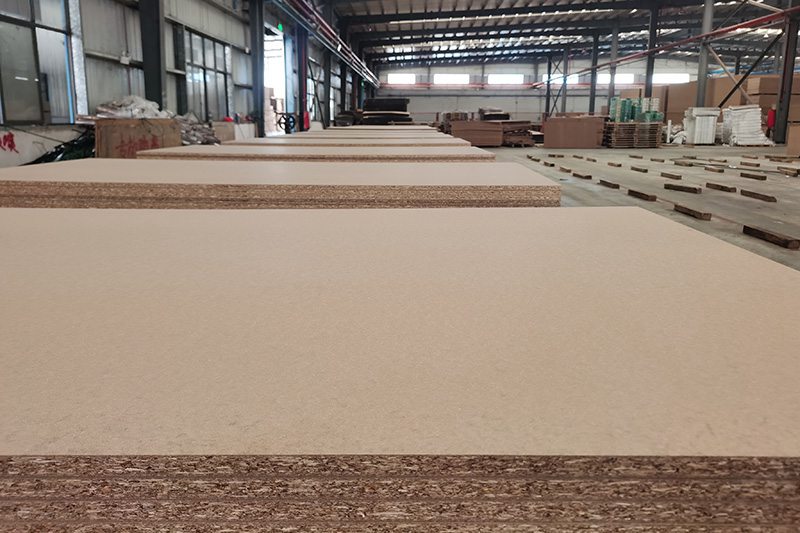Is Particle Board Strong?
Particle Board shows up everywhere: inside flat-pack cabinets, behind closet doors, as worktops under laminate, and even as core panels beneath wood veneer. It’s cost-effective, smooth, and stable in size—but is particle board strong? The honest answer is: it can be strong enough for the right job, but its strength is conditional on density, thickness, edge support, moisture exposure, and how you fasten and span it. This guide explains how particle board is made, what “strength” really means for this material, how it compares to MDF and plywood, and how to design with it so it performs reliably.
1) What Particle Board Is—and Why That Matters for Strength
Particle board (also called chipboard) is a composite panel manufactured from small wood particles—chips, shavings, and sawdust—blended with resin, pressed under heat, and cured into sheets. Understanding its micro-structure explains most of its mechanical behavior.
Manufacture and internal structure.
A typical board has a three-layer build: a fine-particle face on each side for smoothness and a coarser core for bulk. The press consolidates the panel to a target density. Higher density increases interparticle bonding and reduces voids, directly improving bending and screw-holding strength. Resin types vary: urea-formaldehyde is common for standard indoor boards, while melamine-urea-formaldehyde or phenolic resins appear in moisture-resistant or exterior-grade products.
Anisotropy and stress paths.
Unlike solid wood, particle board has no continuous grain; loads spread through a random particle network. That makes the panel dimensionally stable and less prone to warping, but it also means lower tensile strength, especially near edges where particles are larger and bonds fewer.
Face vs. edge behavior.
The faces are denser and stronger than the core. When you load a shelf, the faces carry most of the tension/compression. The edges, being lower density, are the weak link for screws and impacts. This face-core difference is why edge banding and confirmat screws matter so much.
2) How Strong Is Particle Board?
Strength isn’t one number. Designers look at bending, stiffness, fastener holding, and moisture durability. Typical ranges below cover commonly available standard and high-density interior grades; specific products may exceed or trail these values.
2.1 Typical Mechanical Properties
| Property (dry, room conditions) | Standard Density (≈620–680 kg/m³) | High Density / MMR* (≈700–760 kg/m³) | What it Means in Use |
|---|---|---|---|
| Bending strength (MOR) | ~11–16 MPa | ~16–22 MPa | Higher MOR resists cracking when loaded as a shelf or worktop. |
| Stiffness (MOE) | ~1.8–2.6 GPa | ~2.6–3.3 GPa | Higher MOE sags less under the same load. |
| Internal bond (IB) | ~0.30–0.55 MPa | ~0.55–0.80 MPa | Measures glue-line cohesion; affects screw withdrawal and delamination. |
| Screw withdrawal—face | ~900–1,300 N | ~1,300–1,800 N | Screws hold well into the face; pre-drill and don’t over-torque. |
| Screw withdrawal—edge | ~400–800 N | ~800–1,200 N | Edge holding is weaker; use confirmat screws, cams, or dowels. |
| Thickness swell (24 h water) | 12–18% | 6–12% | Swell drives loss of strength; seal edges to limit uptake. |
*MMR = moisture-resistant grade. Values are indicative ranges, not a specification.
Takeaways: density and moisture control dominate performance. A higher-density or moisture-resistant board will feel dramatically “stronger” than a light, budget panel of the same thickness.
2.2 Thickness, Span, and Sag—What You’ll Notice
Sag (deflection) is often the limiting factor for shelves. Two rules of thumb:
Thickness: Jumping from 16 mm to 18 mm increases stiffness by ~40% (stiffness scales with thickness³). A 25 mm top is more than 2× as stiff as 18 mm.
Span: Halving the span reduces deflection by ~8× (deflection scales with span³). Shorter spans are the cheapest “strength upgrade.”
Illustrative shelf guidance (uniformly loaded, typical indoor use):
| Shelf Thickness | Particle Board (standard) | Recommended Max Span for Books* |
|---|---|---|
| 16 mm (⅝″) | Will sag noticeably | ~600–700 mm (24–28″) with front edge support |
| 18 mm (¾″) | Acceptable with edging | ~750–850 mm (30–34″) with 19 mm solid lipping |
| 25 mm (1″) | Quite stiff | ~900–1,000 mm (35–39″) with lipping; more with mid-support |
*Assumes ~40–50 kg/m of shelf load (heavy books). Use a shelf-sag calculator for precise designs.
2.3 Where It Fails—and How to Avoid It
Edge blow-out. Driving wood screws into raw edges can wedge apart the particles. Prevent this by pre-drilling, using confirmat screws (large root, steep thread) or cam-and-dowel fasteners, and by gluing joints as the main strength with screws as clamps.
Moisture swell. Water raises the core, breaks bonds, and permanently weakens the panel. Seal all raw edges, especially sink cutouts, cabinet toe-kicks, and bathroom pieces. Prefer moisture-resistant (green core) grades where splashes or humidity are frequent.
Point loads and impacts. A heavy object dropping on an unsupported span can crush the surface. Add front/back rails or solid lipping (e.g., 18–22 mm hardwood) to turn a weak slab into a box-beam.
2.4 Particle Board vs. MDF vs. plywood (Strength Perspective)
| Criterion | Particle Board | MDF | Plywood |
|---|---|---|---|
| Bending strength | Low–moderate; density-dependent | Moderate; more uniform | Moderate–high; best pound-for-pound |
| Stiffness (sag) | Moderate; needs lipping/short spans | Moderate; similar to PB for equal density | High; cross-plies resist sag |
| Screw holding—edge | Weak unless confirmat/cam | Better than PB but still modest | Good; veneers provide continuous fibers |
| Moisture tolerance | Weak; swells and weakens | Weak–moderate; swells | Good (exterior/balti phenolic glues) |
| Surface smoothness | Good for laminates/veneer | Excellent for paint/laminate | Fair–good; needs more prep to paint |
Bottom line: plywood is strongest per unit weight. MDF machines and paints beautifully. Particle board is the value choice when laminated, well-supported, and kept dry.
3) Designing Particle Board “Strong Enough” (Practical Strategies)
You can make particle board perform impressively by designing to its strengths and guarding its weaknesses.
3.1 Choose the Right Grade and Density
Pick moisture-resistant (MR) boards for kitchens, bathrooms, and laundry rooms. The green-tinted core isn’t waterproof but buys time during spills and cuts thickness swell.
Ask for density data or heft the sheet. Heavier boards (≈700–760 kg/m³) resist fastener pull-out and bending better. For countertops or long shelves, the extra mass is worth it.
3.2 Engineer the Edges: Lipping, Rails, and Banding
Solid lipping (edge strips). Glue a 19–22 mm hardwood strip to the front edge of a shelf or desktop. This increases stiffness like a miniature I-beam flange, dramatically cutting sag and protecting the edge from dings and moisture.
Back rails and side gables. A 60–80 mm back rail (even from PB) glued and screwed transforms a flat shelf into a channel section. Side gables supporting shelf ends further shorten the effective span.
Edge banding. Apply PVC or wood banding to every exposed edge. Beyond looks, it seals the thirsty core and keeps chips from starting at corners.
3.3 Use the Right Fasteners and Joints
Confirmat screws shine in PB. Their large diameter and steep thread bite without splitting; pre-drill pilot and shank holes to manufacturer specs for best holding power.
Cam-and-dowel systems (the flat-pack standard) put the dowel in shear and the cam in compression; the screw threads don’t carry long-term load, so they last longer in PB.
Glue matters. A good PVA (D3/D4) or PU glue layer in carcass joints does the heavy lifting. Treat screws as clamps until the adhesive cures.
Avoid tiny fasteners and close-to-edge drilling; keep at least 8–10× screw diameter from panel edges where possible.
3.4 Control Moisture and Environment
Seal cutouts and end grain. Sink cutouts, dishwasher returns, and floor-level panels are the first to fail. Two coats of polyurethane, epoxy, or even color-matched edge sealant can extend life dramatically.
Float above wet floors. Use plastic feet or treated bases to keep bathroom or laundry cabinets off puddles.
Condition before installation. Let panels acclimate to room humidity for 24–48 hours to stabilize dimensions.
3.5 Smart Use Cases—and Where to Avoid It
Great uses: cabinet boxes behind doors, laminated countertops with strong substrate and front/back rails, closet shelving with lipping, desk tops supported by pedestals or frames, veneered interior panels.
Think twice: outdoor or semi-exposed areas, long unsupported shelves, floors or structural sub-assemblies, and high-impact workshop benches unless fully edged and framed.
Case example—book shelf upgrade:
An 18 mm particle-board shelf spanning 900 mm will sag under heavy books. Glue a 22 mm × 40 mm hardwood lipping to the front, add a 60 mm back rail, and screw the shelf into side gables. That single change can more than halve deflection and significantly boost perceived “strength.”
Conclusion
Yes, particle board is strong enough for many furniture and interior applications when you match the grade and thickness to the job, manage spans, reinforce edges, choose proper fasteners, and keep moisture in check. It will never match the pound-for-pound strength or moisture resilience of plywood, and it won’t hold tiny screws in raw edges like solid wood. But as a laminated, well-supported, indoor panel, particle board delivers durable performance at a fraction of the price.
Previous: Is MDF the Same as Particle Board?


